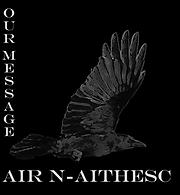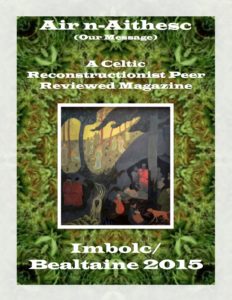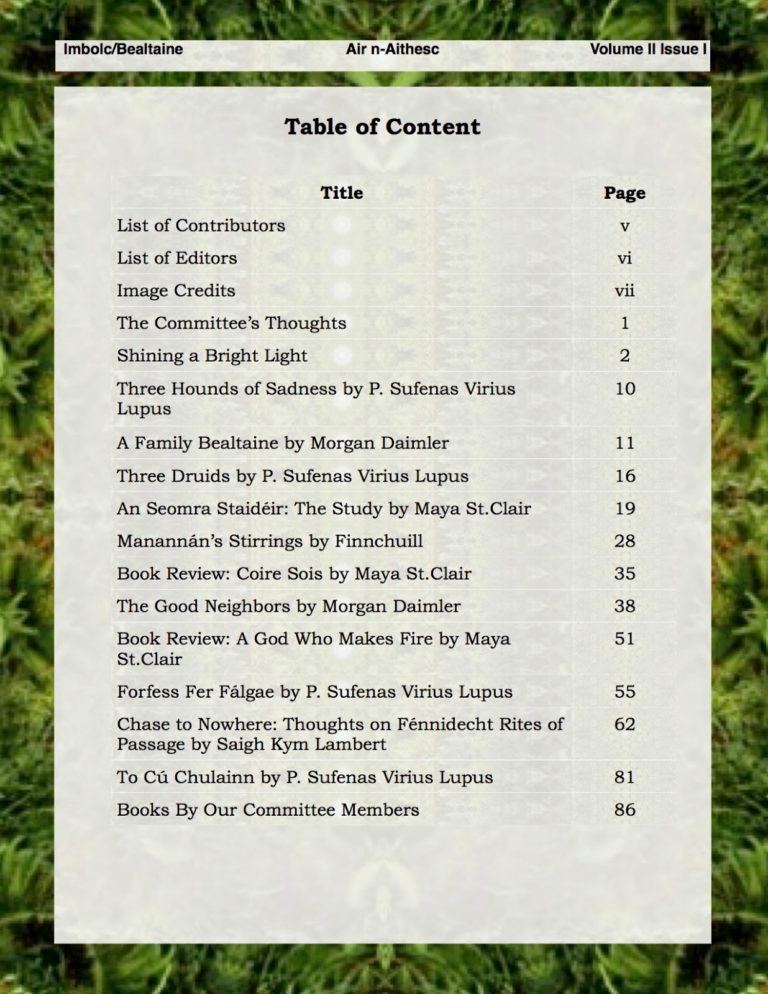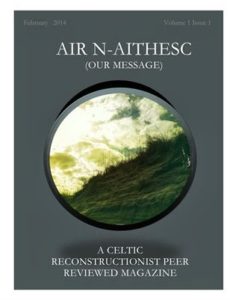Category: Air n-Aithesc
Trying to heal the pack
Crossposted in Dùn Sgàthan blog
So, I’ve not been blogging. I’ve not been writing much, although four days before deadline I decided to whip something together for Air n-Aithesc coming out next week. I’ve not done a lot of the things I hoped to do this summer, including writing and getting my business put back together. Mostly I have hung out with my dogs, either hiding from the heat inside or wandering around or running outside.Sure, I could write while I hide from the burning daystar, but what I’m also not doing is sleeping so concentration isn’t there. It’s been a tough year so far.
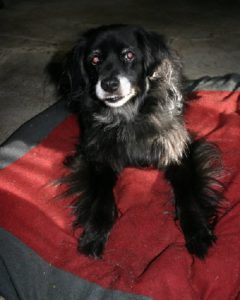 |
| Sachairi |
Last February we lost our 15 year-old boy Sachairi. We had a good two year stretch, after losing our hounds Cù and Òrlaith close together. Sach had liver failure, we tried to stem it with meds but we were told there wasn’t anything else we could do. As he lost interest in life, we let him go. Free of his body, he visits often but can also visit his beloved first human who now lives on an island where dogs cannot be brought in. No physical body, no laws. But it was a rough loss, even if we had adopted him as a senior knowing he would never be with us very long. He made himself very central to our lives, making sure we all were doing what was supposed to be done. He was the dog that when you were upset he’d come over and pat your shoulder and then go get a toy to shove at you to make you feel better. When I needed that this time, well…..
Just a few weeks later – with all of us, pup, human and, yes, the cat still devastated- we took our remaining dogs, Gleann and Gráinne for their yearly shots and checkups. The vet suggested a “wellness” blood work for Gleann as he was about to turn 12. And one for Gráinne as she had displayed symptoms months earlier that indicated a possible autoimmune issue. And…
 |
| Me with Gleann and Gráinne heading to vet |
Gleann has hypercalcemia, high blood calcium of unknown origin, possibly cancer somewhere, but even if not can cause kidney failure. Gráinne has leukemia. Which seemed scarier at first, but really is less of an issue right now, as it is chronic lymphocytic leukemia and currently asymptomatic. The regular vet put her right on Prednisone, which the oncologist (much to the regular vet’s chagrin) had us wean her right off….for some reason our regular vet is insisting she was symptomatic when we brought her in although that had been months before…if she has no symptoms she should not be under treatment for levels she has. We’ll be monitoring her lymphocyte levels monthly and watching her for symptoms.
With Gleann, the oncologist (we should have been referred to an intern, although it probably is cancer) also noted he has a neurological disorder (then the regular vet later taking blood and lymph node samples for test the oncologist ordered, as the regular vet was cheaper and closer for them, also insisted he did not have said eye symptom of it,while then admitting that his head muscles are atrophied from the same disorder. At this, point we have no idea what is causing either of these conditions or how they may relate.
So, those tests were inconclusive, at least according to the regular vet. We need to do ultrasounds and x-rays the regular vet can’t do at the referral vet and to get a consultation from someone there for both sets of tests. We’re broke. Especially after the vet bills for Sach and the horse ones added up last year (and we need to get a vet here for the horses soon too). So we have been fundraising at the page hopefully linked at this widget. I am hoping readers might be willing to help as they can (lots of small donations do add up) and will share this around. If my work has had meaning to you, please consider that this is work and I do not get regular pay for it, so now might be a good time to compensate (an important factor in Gaelic culture, after all) a bit. We need to get answers, we need to treat the cause of theses issues as we can. Chances are, with the possible causes, it is treatable...if we can figure it out in time, but time may be running out fast.
I am hoping that we can get these answers and get Gleann treated. I am hoping to be able to refocus on my writing and get back to taking fitness clients as well as get out to teach some workshops again. (I will likely give a discount to anyone who donates should they wish to do a future workshop or hire me as a trainer…and I am looking at long-distance options). Right now, I’m spending as much time as I can with my pups. Looking forward to our next ritual, as Gleann is our star ritual dog, having participated since he was a couple of months old and absolutely loving it.
 |
| Me with Gráinne, Gleann and Sach just before going out to the hill las Samhuinn |
Excerpt from “The War Goddess’s Bitch”
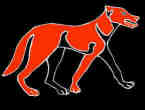 This is from my article in Air n-Aithesc Vol III, Issue 1 currently available in hard-copy or e-copy from this link. Unlike previous excerpts, this in not the beginning of it, as I began with a dream sequence that would be too long for a lead in and I don’t want to post only part of. The article is a continuation of my exploration of the fénnidecht wolf-warrior path, specifically how I follow it as a devotion to the Morrígan and some material on female werewolves, weredogs and dog-heads.
This is from my article in Air n-Aithesc Vol III, Issue 1 currently available in hard-copy or e-copy from this link. Unlike previous excerpts, this in not the beginning of it, as I began with a dream sequence that would be too long for a lead in and I don’t want to post only part of. The article is a continuation of my exploration of the fénnidecht wolf-warrior path, specifically how I follow it as a devotion to the Morrígan and some material on female werewolves, weredogs and dog-heads.
The War Goddess’s Bitch
Wolf-warrior cults are usually attributed to male Gods. The Vedic Indra and Rudra, the Germanic Odin and the Greek Apollo Lykeios have all been associated with wolfish warrior bands.[i] Kershaw states that there are no known Celtic Gods associated with warbands, other than seeing a similarity between Finn and the Fíanna and Rudhra and the Maruts.[ii]Kershaw also mentions McCone’s pairing of Ódinn/Týr and Lug/Núada as teuta/koryos(civilization/warband or wild) God pairings.[iii] Lug is certainly a candidate for such a warrior cults: His relationship to both Cú Chulainn and Finn, adds to this possibility.[iv]While I would not argue against Lug, Finn (as a God, although I tend to focus on his nature as a semi-divine hero) or other Gods as having had such cults, I believe that it is as likely that the Goddesses who fall under the title the Morrígan were also likely to have been the Divine leaders of such cults.
The Morrígan’s interest in Cú Chulainn, the Hound of the Smith, is evident throughout the TBC and related Ulster tales. Some see their relationship as confrontational, often confusing. Epstein has speculated that She may indeed be his patron Deity.[v] Epstein noted that the seemingly adversarial nature of Her relationship with Cú Chulainn can be seen as an effort to strengthen his glory, as I have also explored.[vi] Epstein specifically brought up the similarities between his canine nature, which goes far deeper than just a name, and the Norse ulfheðnar (“wolf coats”) and berserkr (“bear coats”) who followed Odin. She speculated that this might hint at an ecstatic cult dedicated to an Morrígan.[vii]
This ecstatic, shape-shifting nature suggests such a cult as well as the obvious canine connection. Cú Chulainn’s name connects him with canines: he is the Hound, actually acting as Culainn’s guard dog as a boy, to replace the dog he killed.[viii] Yet his form of shape-shifting, his ríastrad (warp spasm), is not decidedly canine. By killing the guard dog and then assuming the dog’s role, Cú Chulainn was transformed completely into a hound not only for his time of service to the Smith but for the rest of his life.[ix]He was always a hound. He was just wilder, more dangerous, rabid, when he transformed and he described himself as having canine fury in Tochmarc Emire.[x]His identity as the Hound was so significant that when St. Patrick conjured Cù Chulainn’s specter in order to convert Lóegaire, the king of Ireland, the specter’s canine nature convinced the king that the specter was truly Cú Chulainn.[xi]
Cú Chulainn’s story gives no indication of him as part of a warband. This lack is likely related to animosity between the church and such warriors they called díberga (marauders, brigands).[xii] It is notable that the ecstatic transformation and the connection to a Deity were revealed at all. When the stories of warbands were finally set down, the Fíanna seem quite divorced from the earlier, negative, accounts of the díberga, that displayed little association with either shape-shifting or Deity.[xiii] The association with hounds is strong in the stories around Finn Mac Cumhail. There are many members of the Fíanna with canine names. However, the fénnidi’s own canine nature is only hinted at vaguely. Finn did have the hood of Crothrainne, which allowed him to turn to hound or stag, yet there is little evidence of him using it.[xiv]In one alternative tale of the birth of Bran, Finn was his father by a woman enchanted into the form of a bitch. One might choose to speculate that he used the hood at that time.[xv]
Read more by purchasing AnA here
[i] Kris Kershaw, The One-eyed God: Odin and the (Indo-) Germanic Männerbünde, Journal of Indo-European Studies, Monograph No. 36., Washington D.C.: Institute for the Study of Man Inc., 2000, such Gods and Their cults are the subject of the entire study, however particular interest might rest in ch. 9 “Odin Analogues” pg. 182-200; Dorcas Brown and David Anthony, “Midwinter Dog Sacrifices at LBA Krasnosamarskoe, Russia And Traces of Initiations for Männerbünde” Paper presented, Conference: Tracing the Indo-European: Origin and migrations. Roots of Europe Research Center, University of Copenhagen, Denmark Dec 11–13, 2012.[ii] Kershaw, The One-eyed God, pg. 186.[iii] Kershaw, The One-eyed God, pg. 195.[iv] C. Lee Vermeers discussed his relationship with Lú Ardáinmór as a lycanthropic God in a blog post http://faoladh.blogspot.com/2013/05/what-i-domy-own-gods-part-one-my-upg-so.html and has also talked about Apollo as a Wind-Wolf God, http://faoladh.blogspot.com/2011/05/gods-and-goddesses-of-werewolves-wind.html[v]Epstein, “War Goddesses,” Ch. 2.[vi]Epstein, “War Goddesses,” Ch. 2; Lambert, “Musings on the Irish War Goddesses;” also further explored in my blog post “The Morrígan and Cú Chulainn part 1: On Saying ‘No.’”[vii]Epstein, “War Goddesses…,” Ch. 3.[viii]TBC Rec 1 pg. 17-19,140-142; TBC:BOL pg. 23-25, 160-163.[ix] McCone, “Aided Cheltchair Maic Uthechair: Hounds, Heroes and Hospitallers in Early Irish Myth and Story.” Ériu 35, 1984 pg. 8-11, I discuss this act as being linked to wolf-warrior initiations in “Going Into Wolf-shape.”[x]Bernhardt-House, Werewolves, Magical Hounds, and Dog-headed Men, pg. 174, 343.[xi]Joseph Falaky Nagy, Conversing with Angels and Ancient: Literary Myths of Medieval Ireland, Ithaca: Cornell University Press, 1997, pg. 274.[xii] Kim McCone, “Werewolves, Cyclopes, Díberga and Fíanna: Juvenile Delinquency in Early Ireland” Cambridge Medieval Celtic Studies, issue 12, 1986, pg. 3-4; Sharpe, “Hiberno-Latin Laicus, Irish Láech and the Devil’s Men,” Ériu 30, 1979, pg. 80-87.[xiii]Kim McCone, “Werewolves, Cyclopes, …”, pg. 3-4; I discuss other links between the díberga and the Fíanna and canine nature further in “Going Into Wolf-shape” as well.[xiv]Kuno Meyer, ed. and trans., “The Finn episode from Gilla in Chomded húa Cormaic’s poem “A Rí richid, réidig dam” Fianaigecht, 1910, Hodges, Figgis & Co., Dublin, Ireland, pg. 51. http://archive.org/details/fianaigechtbeing00meye[xv]As we’ll discuss shortly, Bran and Sceolang are more commonly said to be the children of Finn’s aunt, however, this tale is noted by Bernhardt-House, Werewolves, Magical Hounds, and Dog-headed Men, pg. 196.
Copyright © 2016 Saigh Kym Lambert
Wolf Copyright © 2002 Aaron Miller, based on Newbigging Leslie stone
Return of Warriors for the Horse Goddess
I had pulled Warriors for the Horse Goddess from the website several months ago to expand and submit to Air n-Aithesc where it was published in Vol. 2 Issue 2, Lughnasadh/Samhain 2015. The contract with AnA before rights return is for 3 months, however, I usually would wait for at least 6 months as I do feel it makes more sense to wait until the next issue is out. However, for this article I am making an exception and I have returned it, updated and in PDF form to the website.
Warriors for the Horse Goddess

Moving things around and more re-self-publishing
Some, maybe, have noticed that I have moved the website to http://dunsgathan.net/feannog/ the old folder will forward you there from old links.
At the same time, I have also created a page to house links (this link goes to said page) to PDFs of articles originally published in Air n-Aithesc (this link goes to the magazines page)
At this time the page has “‘By Force in the Battlefield’: Finding the Irish Female Hero” and “Going into Wolf-Shape” up. Will get the other two I have ownership of up in the near future.
Biannual Publication Announcement – Air n-Aithesc vol. II issue 1
The Imbolc/ Bealtaine 2015 issue of Air n-Aithesc is out now and you can order at the link!
The table of contents is below so see what all is offered. More poetry and prose from PSVL, two articles by Morgan Daimler, an article from Finchuill and book reviews and An Seomra Staidéir from Maya St.Clair.
My article this issue is “Chase to Nowhere: Thoughts on Fénnidecht Rites of Passage” which discusses ideas gleaned from the literature and other sources about the very non-linear rites which might have been associated with the Irish warbands and some ideas about modern incorporation.
Excerpt from “Going into Wolf-Shape”
This is my last of the excerpts from past issues of Air n-Aithesc that I have to share. I have previously posted excerpts from “Muimme naFiann: Foster-mother of heroes” and ‘“By Force in the Battlefield”: Finding the Irish Female Hero’. The rest of this one can be found in the first issue, Vol 1, Issue 1.
 The next issue should be out at Imbolc, in just a few weeks. I will try to post excerpts in a more timely manner at that point. ~;) Or maybe I’ll even blog something else. ~:p
The next issue should be out at Imbolc, in just a few weeks. I will try to post excerpts in a more timely manner at that point. ~;) Or maybe I’ll even blog something else. ~:p
Going into Wolf-Shape
Humans have lived with dogs for possibly somewhere between 18,800 and 32,100 years, earlier than previously believed.[i]Given highly social nature of both humans and canines and our mutual ability to hunt in groups requiring good communication skills, it seems natural that the relationship would have started when we were hunter-gatherers. Early Neolithic dog burials in Siberia suggest that during this period dogs held an high status not far below humans, beyond their “utilitarian” usefulness.[ii] How natural the relationship is between humans and canines is something most who live with dogs would readily argue, our ability to relate is a given for us. Science has been proving this point, communication and emotional response are strong and similar.[iii]It would be more amazing if humans and wolves—for dogs are wolves who choose to adapt to live in human packs—had not bonded.
There is a great deal of lore and history regarding the importance of dogs among the Gaelic and other Indo-European cultures. Recent genetic testing has revealed that the rose-eared sighthound originated among the Celtic people.[iv] This ancient hound was the ancestor of the modern Greyhound, the Scottish Deerhound, as well as the Galgo Español, which is probably very similar to the ancient hounds. The warrior and the canine are repeatedly linked in Irish lore. One Irish term for wolf, “mac tire” (literally “son of the land”), seems to have first meant a “vagabond warrior” came to primarily mean “wolf.”[v] Many warriors and kings bore “hound” or “wolf” in their names.[vi] The most recognized is Cú Chulainn, who, as a child, took the very role he became named for, “Culainn’s hound,” after killing the smith’s original guard dog in self-defense.[vii] The Fíanna were renowned for their hunting hounds.[viii]
Read the rest by purchasing Air n-Aithesc Vol 1, Issue 1
[i] Elizabeth Pennisi, “Old Dogs Teach a New Lesson About Canine Origins” Science Magazine Vol. 342 no. 6160, November, 15 2013 http://www.sciencemag.org/content/342/6160/785.full
[ii] Robert J. Losey, et al “Burying Dogs in Ancient Cis-Baikal, Siberia: Temporal Trends and Relationships with Human Diet and Subsistence Practices,” PLoS ONE 8(5) 2013 http://www.plosone.org/article/info:doi/10.1371/journal.pone.0063740?
[iii] Gregory Berns, How Dogs Love Us: A Neuroscientist and His Adopted Dog Decode the Canine Brain, New Harvest, 2013
[iv] Heidi G. Parker, Lisa V. Kim, Nathan B. Sutter et al, Genetic Structure of the Purebred Domestic Dog Science, 21 May, 2004: Vol. 304 no. 5674, pg. 1160-1164 https://www.princeton.edu/genomics/kruglyak/publication/PDF/2004_Parker_Genetic.pdf
[v] Kim McCone, “Varia II.” Ériu 36, 1985 pg. pg. 173
[vi] Joseph Falaky Nagy, The Wisdom of the Outlaw: The Boyhood Deeds of Finn in Gaelic Narrative Tradition, Berkeley: University of California Press, 1985, pg. 44, although far more is in this pages notes 19-22 found on 243-245; McCone, “Aided Cheltchair Maic Uthechair pg. 1-30, especially noted on pg. 12-14
[vii]Cecile O’Rahilly, trans., Táin Bó Cúalngefrom Book of Leinster Dublin: Dublin Institute for Advanced Studies, 1967 English http://www.ucc.ie/celt/published/T301035/index.html Irish http://www.ucc.ie/celt/published/G301035/index.html pg. 23-25, 160-163; O’Rahilly, trans. Táin Bó Cúalnge, Recession 1 Dublin: Dublin Institute for Advanced Studies, 1976 English http://www.ucc.ie/celt/published/T301012/index.html Irish http://www.ucc.ie/celt/published/G301012/index.html pg. 17-19,140-142
[viii] J. R. Reinhard and V. E. Hull, “Bran and Sceolang,” Speculum 11, 1936, pg. 42-58, Nagy, The Wisdom of the Outlaw, pg. 44, 95-97
Copyright © 2014 Saigh Kym Lambert
Excerpt from ‘“By Force in the Battlefield”: Finding the Irish Female Hero’
I’m still not feeling real bloggy so I thought I’d do another teaser for those who are not reading Air n-Aithesc yet. Which is where my writing lives these days…while we wait for the third issue to come out on Imbolc. This is one of two from the first issue which can be purchased here. Unfortunately, this one does start out a bit depressing, you really do have to buy the magazine to find the more positive spin. ~;p
“By Force in the Battlefield”: Finding the Irish Female Hero
When an Morrígan came into my life in the late ‘80s, She tasked me with two duties that it was clear I must work on. One was to reexamine my pacifist habits and begin walking the warrior path in very concrete ways, which included physical training I never would have previously considered. The other was to learn as much as I could about Her culture, to try to find practices that were as much in keeping with it as I could. I knew both challenges would be difficult, but at least I had many heroic female warriors from Celtic history and myth to inspire me.
Sadly, as I got more into the cultural studies, even changing my focus at college to concentrate on women in the Celtic cultures, I learned differently about all those warrior women. Having had only shallow exposure to Celtic history and literature before, mostly through the lens of the Pagan community I was involved in, it certainly seemed that there had been a lot of material that I was about to wade more deeply into. Yet, the truth is that I already had heard retellings, often exaggerated, of most of what was there. There were a few new names and short tales, sometimes only a sentence or two long, I had yet to discover, but very few. I also realized that most of the major names I already knew really had very little information behind them, other than Medb.
Previously I posted an excerpt from “Muimme naFiann: Foster-mother of heroes” which is in the second issue.
Copyright © 2014 Saigh Kym Lambert
Excerpt from “Muimme naFiann: Foster-mother of heroes”
I’ve not blogged for awhile and am not sure when I will again. My writing focus was on getting a new submission for the next Air n-Aithesc and since submitting it we’re trying to catch up on winterizing here, the flu had floored me during the time I had 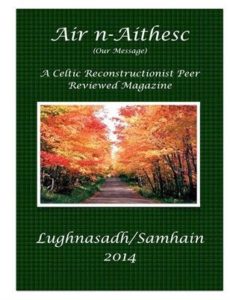 hoped to be doing most of this. As I have my submission for the summer issue done (for the most part, current reading may make for a few alterations), I am hoping to focus on cobbling some of this stuff I’ve been putting into articles back into Teh Project which, you know, it was all stolen from to begin with. ~;p (ETA: also need to get in some CEUs and will probably rewrite some fitness stuff specifically focused on the training program) So….I figured I’d copy fellow AnA writer Morgan Daimler and post an excerpt from my article “Muimme naFiann: Foster-mother of heroes” in the current issue. That would be Air n-Aithesc Volume I Issue II Lughnasadh/Samhain which you can order right at that link should you wish to read the rest…
hoped to be doing most of this. As I have my submission for the summer issue done (for the most part, current reading may make for a few alterations), I am hoping to focus on cobbling some of this stuff I’ve been putting into articles back into Teh Project which, you know, it was all stolen from to begin with. ~;p (ETA: also need to get in some CEUs and will probably rewrite some fitness stuff specifically focused on the training program) So….I figured I’d copy fellow AnA writer Morgan Daimler and post an excerpt from my article “Muimme naFiann: Foster-mother of heroes” in the current issue. That would be Air n-Aithesc Volume I Issue II Lughnasadh/Samhain which you can order right at that link should you wish to read the rest…
Muimme naFiann: Foster-mother of heroes
When the subject of women warriors come up, Scáthach, Cú Chulainn’s teacher, is one of the first noted, along with Medb. Yet even more so than Medb, Scáthach’s story is not her own but a very brief part of Cú Chulainn’s. Much of what is “known” about her today is embellishment. The idea that she is the eponymous Goddess of the Isle of Skye, [i] is a Goddess of War, the dead and even blacksmiths is found repeated within Pagan sources.[ii] However, while some of these concepts, like the association with Skye, did come about late within Gaelic culture, the others appear to have developed even later outside of the culture, primarily within the Pagan community.[iii]
What we do know about her is that she taught warriors, most notably Cú Chulainn, and had a gift of prophecy. And in this she is not alone, for Finn Mac Cumhail’s lesser-known foster-mother(s), especially Bodbmall, shared similar traits. Nagy stated, “…it would seem that Bodbmall, Búanann, and Scáthach are all multiforms of a supernatural martial foster-mother figure who appears in various contexts.”[iv]We have no stories for Búanann. Scáthach is called Scáthaig Buanand in one version of the Táin Bó Cúalnge, which O’Rahilly translates as “Scáthach the victorious.”[v] The name, however, appears in the Sanas Cormaic (“Cormac’s Glossary”) described as “muimme nafiann”(“foster-mother of heroes”) and related to the role of Anann as mother of the Gods.[vi]Anann is one of the Daughters of Ernmais, the one usually identified as the Morrígan.[vii]
Many scholars do read these foster-mothers as supernatural beings, although seldom as actual Goddesses. [viii] Certainly, Scáthach’s distant and hard to reach land and Finn’s fosterers’ wilderness hide-outs as well as their powers both as a warriors, often seen as unnatural for women, and as seers indeed mark them as Otherwordly.[ix] Scáthach’s title of “Búanann,” and the name’s connection with the Goddess Anann, may make Scáthach seem to be the Goddess. Likewise, a possible etymological relationship between the names Bodbmall and Badb raises the question as to whether she is supposed to be this War Goddess.[x]
Read the rest by purchasing Air n-Aithesc Volume I Issue II Lughnasadh/Samhain
[i] There are a multitude of examples. Caitlin Matthews directly uses these words to describe her in several books, for example The Elements of the Celtic Tradition, Element Books, 1989, pg. 76.[ii] I will not pick out one source for much of this, as where any of it came from originally is impossible to say. A quick online search brings up thousands of websites, often directly repeating each other with no further sourcing.[iii] Isle of Skye part has shown up even in somewhat academic sources. (James MacKillop. Dictionary of Celtic Mythology, New York: Oxford University Press, 1998, pg. 410 for example) How old a connection this was and when Scáthach became connected to the MacDonald fort Dun Scaith is difficult to determine. The earliest reference I found to that she was on Skye was in Macpherson’s “Ossian” inventions of the mid-18th century where he places her at the site and gives Cú Chulainn the Dun in another tale.(James Macpherson, The poems of Ossian, tr. by J. Macpherson. To which are prefixed dissertations on the era and poems of Ossian, Oxford University Press, 1805, pg. 149; Macpherson, Hugh MacCallum, John MacCallum, “Conlaoch,” An original collection of the poems of Ossian, Orann, Ulin, and other Bards, who flourished in the same age, Watt, 1816, pg. 153-158; John Gregorson Campbell also includes this location in recounting Macpherson’s version of “Conlaoch” in The Fians: or Stories, Poems & Traditions of Fionn and His Warrior Band, Elibron Classics, 2005 (org. pub. Date 1891), pg. 6) Stokes determined that the similarity between the Gaelic term for the Isle of Skye (An t-Eilean Sgitheanach) and Scythia (Scithia) was all that caused this connection, which he notes as popular at the time. (Whitley Stokes, “The Training of Cúchulainn,” Revue Celtique 29, 1908, pg. 109 https://archive.org/details/revueceltiqu29pari).[iv] Joseph Falaky Nagy, The Wisdom of the Outlaw: The Boyhood Deeds of Finn in Gaelic Narrative Tradition,Berkeley: University of California Press, 1985, pg. 264, footnote 13 following from pg. 102.[v] Cecile O’Rahilly, trans. Táin Bó Cúalnge from Book of Leinster Dublin: Dublin Institute for Advanced Studies, 1967, pg. 95, 231 Irish http://www.ucc.ie/celt/published/G301035/index.html English http://www.ucc.ie/celt/published/T301035/index.html[vi] John O’Donovan, ed. and trans. (with notes and translations from Whitley Stokes) Sanas Cormaic Calcutta: O. T. Cutter for the Irish Archeological and Celtic Society, 1868, http://books.google.com/books?id=rX8NAAAAQAAJ&source=gbs_navlinks_s pg. 17;Whitley Stokes, ed., ‘Cormac’s Glossary’ in Three Irish Glossaries, London: Williams and Norgate, 1862 http://www.ucd.ie/tlh/text/ws.tig.001.text.html pg. 6; see also Nagy Wisdom of the Outlaw, pg. 102; Angelique Gulermovich Epstein, “War Goddess: The Morrígan and her Germano-Celtic Counterparts” dissertation, University of California in Los Angeles, 1998 ch. 2.[vii] Epstein, “War Goddess,” ch.1; Kim Heijda, “War-goddesses, furies and scald crows: The use of the word badb in early Irish literature” thesis, University of Utrecht, Feb. 27, 2007 http://igitur-archive.library.uu.nl/student-theses/2007-0620-200703/UUindex.html pg. 34; Robert A. Stewart MacAlister, ed. and trans., Lebor Gabála Érenn: The Book of the Taking of Ireland, Vol IV. Dublin: Irish Text Society, 1941 http://www.archive.org/details/leborgablare04macauoft pg. 103, 130-131, 160-161, 188-189, I also discuss Anann as the Morrígan in “Musings on the Irish War Goddesses,” Nicole Bonivusto, ed. By Blood, Bone and Blade: A Tribute to the Morrigan Asheville, North Carolina: Bibliotheca Alexandrina, 2014, pg. 103.[viii] Proinsias Mac Cana mentions Scáthach briefly under the heading of “Goddesses of War” on page 86 of Celtic Mythology, NY: Peter Bedrick Books, 1987, yet refers to her as “supernatural” on page 102; Rosalind Clark. The Great Queens: Irish Goddesses from The Morrigan to Cathleen ni Houlihan, Savage, MD: Barnes and Nobel Books, 1991 pg. 28.[ix] Miranda Green, Celtic Goddesses: Warriors, Virgins and Mothers, New York: George Braziller, 1996, pg. 149; Nagy, The Wisdom of the Outlaw, pg.109-111.[x] Epstein, “War Goddess,” ch 2.
Copyright © 2014 Saigh Kym Lambert
Biannual Publication Announcement – Air n-Aithesc 2
Yup we did it! With Maya St.Clair doing the bulk of the actual work. We got issue two of Air n-Aithesc published!
And yes, I have an article entitled “Muimme naFiann: Foster-mother of Heroes” where I discuss the storys of Scáthach and Finn’s variously named foster-mothers…or rather where they come in in the heroes’ stories as they sadly have none of their own. This is, of course, always a part of this project I’m doing here.
You can order through the website or just go to Magcloud…you can, of course, still get our first issue if you have missed it.
